The pull-up might be the best indicator of upper body strength.
Your arms and back have to do an enormous amount of work to lift your entire body, which is why being able to perform many reps is an effective way to improve not just the obvious muscles — your back, arms and forearms — but can also help you build incredible core strength.
In fact, as an exercise physiologist and strength coach, I’d go so far as to say that the pull-up is the world’s most under-appreciated way to develop your abs—and every other muscle in your midsection, for that matter.
All of that is great, but there’s one problem: It’s an exercise that gives a lot of people a lot of trouble, regardless of whether you’ve been training for years or just started.
If you are struggling to perform a pull-up — or you wish you could do many more — I’ll share a few simple-to-learn techniques that aren’t taught enough and will change everything about your pull-up performance.
By the time you’re done, you’ll not only be surprised by how quickly you can improve, but also by how many of the methods used to increase your upper body strength aren’t actually pull-ups.
Can’t Do a Pull-up? Start Here
If you can’t do any pull-ups, odds are you’ll blame it on your lack of back strength. To become stronger, you might start doing countless 1-arm rows and other dumbbell or barbell exercises.
While those exercise will make you stronger (and are a part of the solution), they won’t guarantee that you’ll be able to do more pull-ups. That’s because pull-ups aren’t just about your back.
Even if you have a really strong back, you can struggle with pull-ups if you have a weak core.
Core stiffness, or being able to create tension throughout your torso, is a key part of successfully doing a pull-up.
Your shoulder blades are connected to your torso. A stiff, stable core gives your arms something strong to pull on. And that can have a massive impact on your ability to lift your body.
So if you are struggling with your pull-ups—or can’t do a pull-up at all—train your core with these moves.
(If you prefer to watch all tips, here’s a video breaking down a lot of the progressions we’ll discuss today. In it, you’ll see my friend and fellow coach Tony Gentilcore demonstrating a lot of the moves discussed here.)
Hollow Body Holds
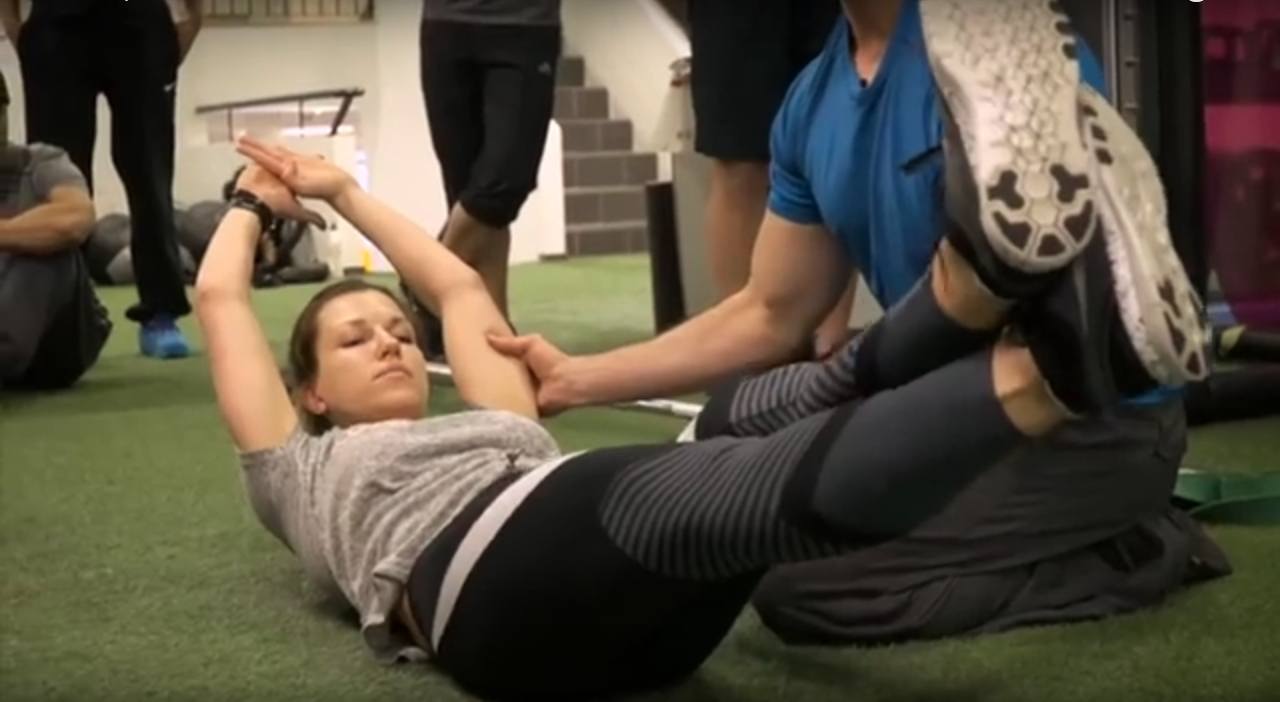
Start by lying on the floor. Lift your arms overhead (biceps in line with your ears), keeping your elbows straight.
Cross your hands and your ankles. Then press your hands and ankles into each other to create tension, and lift up into the hollow body position.
Let’s talk about that term “hollow” for a second. You might hear it and think: “belly button to spine.” DON’T DO THAT.
In a good hollow position, your abs are securely braced, as if they were about to take a punch. Take a breath in and squeeze. If anything, your abs will move slightly outward.
Start by holding a hollow body position while pressing your hands into each other and pressing your ankles into each other. This builds some of the body tension related to the position of hanging from a bar.
Hold this position for 5 seconds or 2-3 breaths per rep, maintaining as much head-to-toe tension as you can (more on how to create tension). Take a 5-second break, then repeat for 5-6 reps per set. Over time, you can increase the duration of your holds. If you can maintain tension for a full minute, that’s really good.
Hollow Body Horizontal Pull-ups
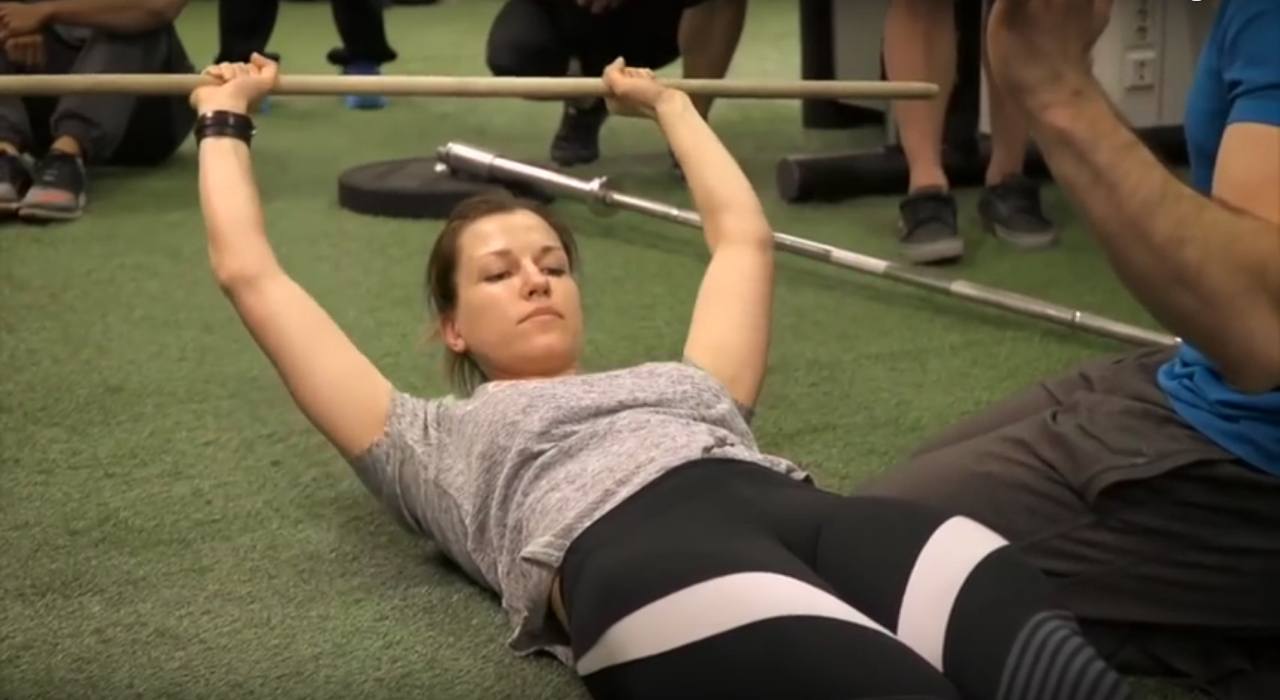
Next, you’re going to use a dowel or broomstick. Hold it in both hands as if it were the pull-up bar.
Start with your arms straight and elbows locked out, as if you were hanging from a pull-up bar. Then, while you hold the hollow position, bend your elbows to pull the bar across your face and toward your chest line, mimicking the pull-up movement.
The goal here is to maintain the core strength requirement while including an arm movement that replicates the pull-up—all while trying to breathe.
Hold the hollow body and try to complete 8-10 reps, breathing out as the bar comes to your collarbone.
Hollow Body Leg Raises
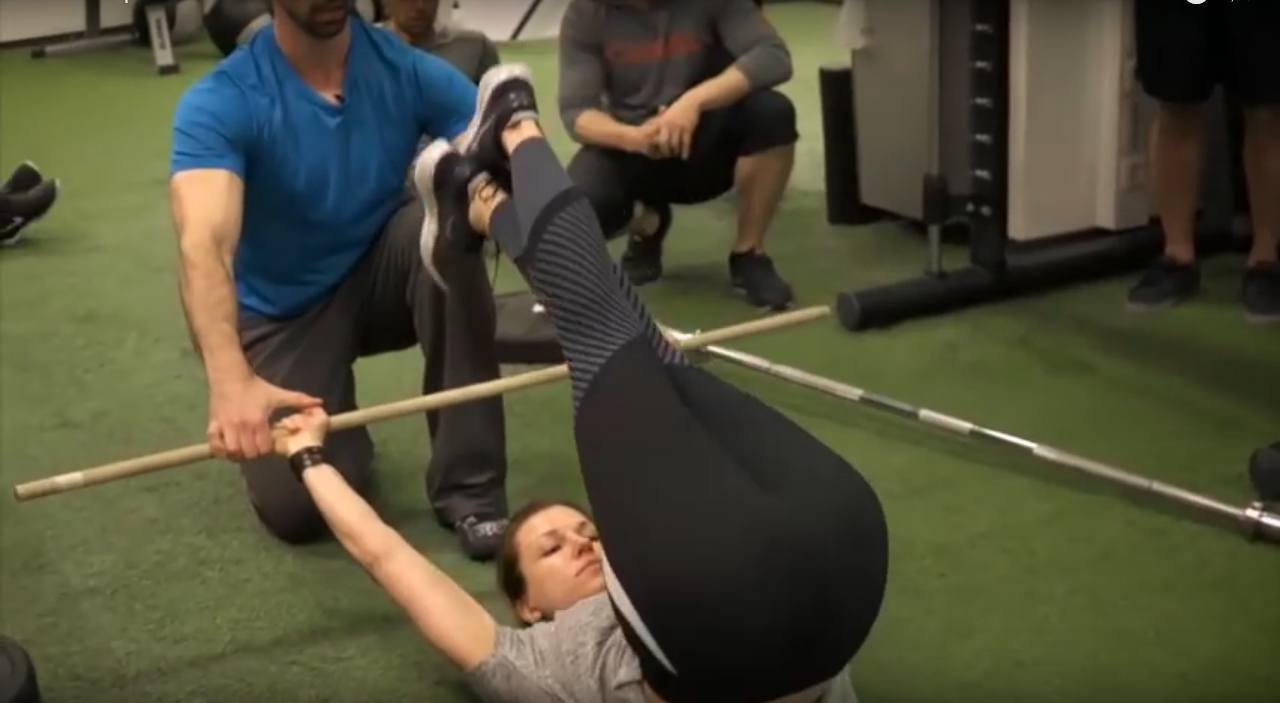
Are you a boss at the hollow body work? Great! Then it’s time to take it up another notch.
You can create some additional arm stimulus, and increase the challenge to your core, by doing a leg raise. Keep both knees locked out and cross one foot over the other. Pull down on the stick and lift your toes toward it. You may even be able to touch your toes to the bar, depending on your level of strength and control.
The big thing to remember here is to maintain tension throughout your lats to help pull your torso up. Squeeze the bar as hard as you can in your hands and think about pulling down on the bar as much as you are pulling up with your legs. This tension in your arms, back and core will help you lift your legs more easily.
Perform a set of 5-8 reps.
Stability Ball Rollouts
Another exercise that develops core stiffness is a stability ball rollout. There are two ways you can perform the movement, and both are helpful to your pull-up quest.
Option #1: Try to keep your abs tensed and press your hips forward, allowing your arms to extend out as you move. Then pull back with your hips. This version will place more emphasis on your abs and lower back, while taking some of the work off of your shoulders
Option #2: Do the same thing as you did in option #1, but use your lats to try and pull the ball back with your elbows to return to the starting position. In this version the shoulder angle is changing, which means the muscles that control the shoulders will be under greater load.
Complete 5-10 reps of either option, or both if you’re a little crazy.
How to Build Strength on the Pull-up Bar
Before you start pulling, it’s helpful to build your skill hanging from the bar.
Bar Hang
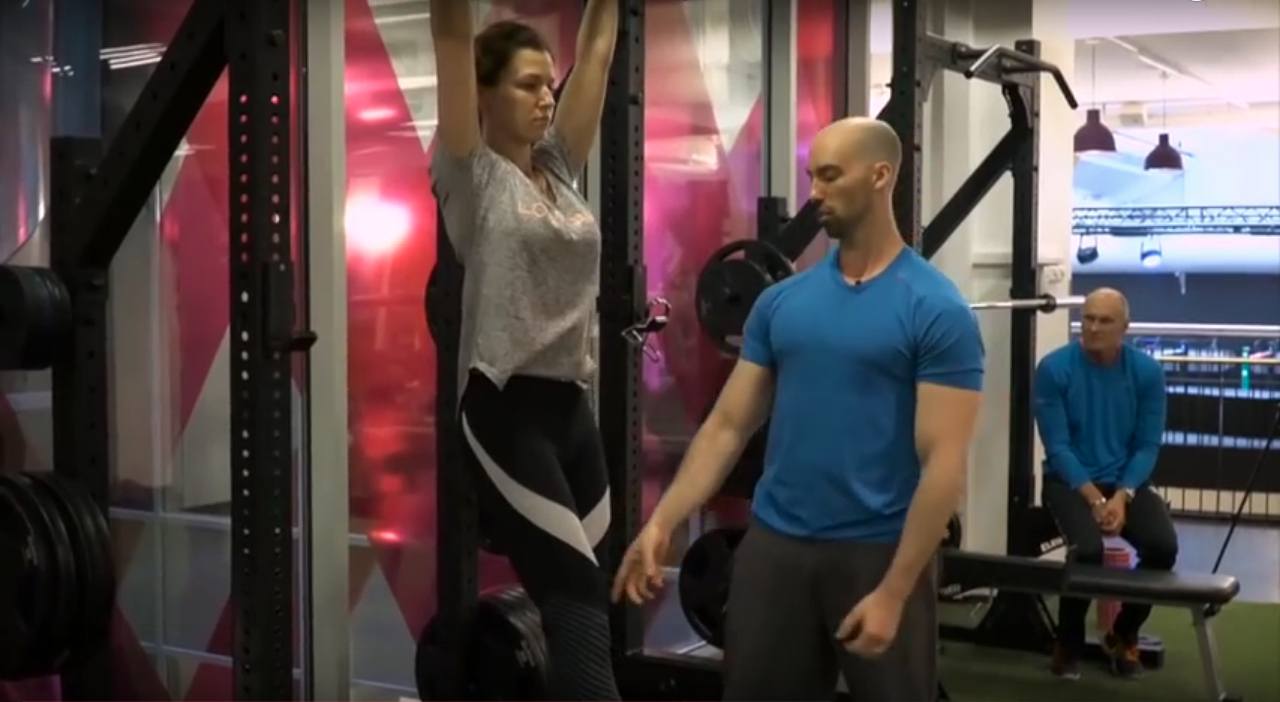
You might struggle at maintaining a dead hang from the bar due to grip strength. Hanging for 10-30 seconds can be a simple and very effective way to build the grip strength needed to perform pull-ups.
Hanging Shoulder Shrugs
When you can conquer that challenge with ease, your next goal is pulling your shoulders down and tight to your ribs while holding the same hollow body position you used on the ground.
Hold that position for 5 seconds per rep, breathing out forcefully with each contraction.
Hanging Leg Raises
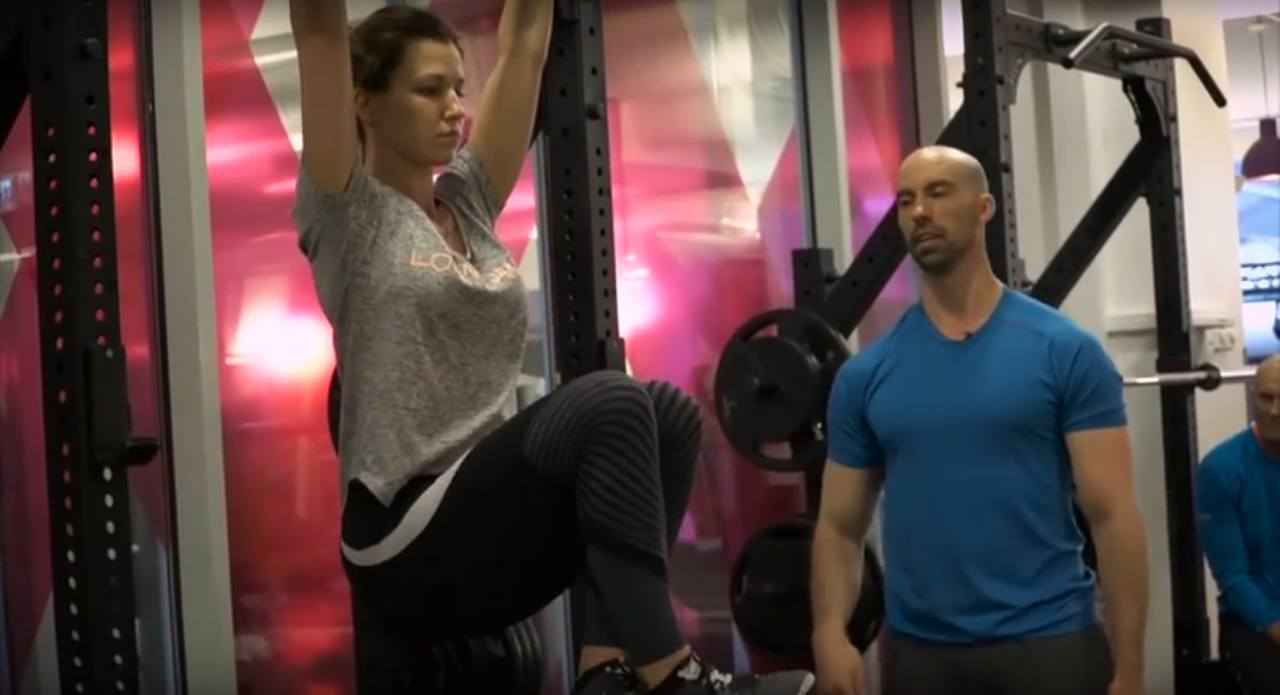
Have the hollow body hang down cold? Good. You can add in some leg raises to really take it up a notch.
Start with a bent knee leg raise. The key is to not sway.
If that’s no problem, try a straight leg raise. Again, you want to avoid rocking back and forth. The movement should be slow and controlled.
In all likelihood, you will find at least one of these moves challenging. Because your goal with these is quality, not quantity, you can use “micro sets” to accumulate volume. Try to hit 10 amazingly good reps total. To do that, you might need to perform 5 sets of 2, or 4 sets of 2-to-3, or 3 sets of 3, and so on.
If you wanted to get a little crazy, you could try to bring your toes to the bar. Use your arms to help pull-up on your torso to get a more horizontal angle on the movement.
Pull-up Training: Mastering the Movement
Now let’s “grease the groove” of the movement in a way that will help you develop strength if you’re a beginner, and provide value if you’re more advanced.
Flexed Arm Hang
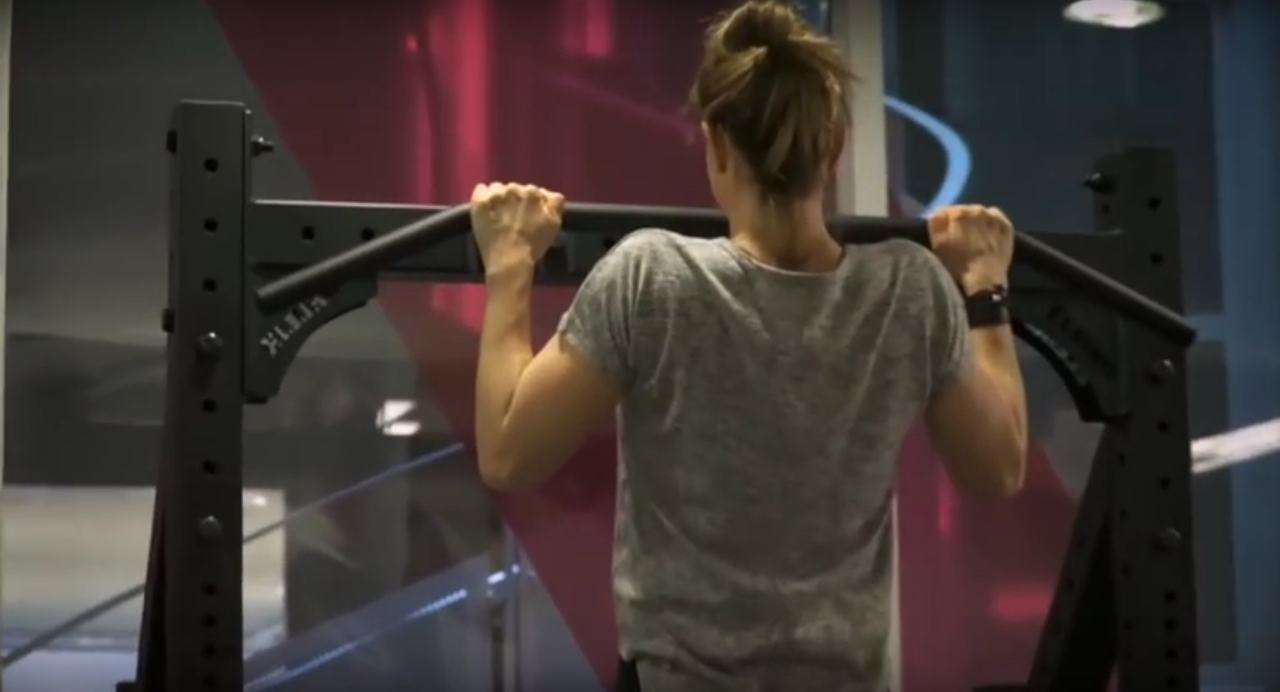
The flexed arm hang is a simple, yet underutilized move that will have all the muscles in your back and arms firing hard.
To perform the move, just grab the bar and jump up. Keeping your chest as close to the bar as possible, hang there as long as you can tolerate. When you start to feel yourself coming down, fight the lowering for 3-5 seconds so you can get some eccentric strength development out of the move.
Try to maintain 10 to 30 seconds per hold, accumulating up to 30 seconds in a workout. For eccentric reps, try to keep it to a max of 5 reps of 3-5 second eccentric lowering unless you want to look like a T-Rex for a few days after your workout because you’re too sore to extend your elbows.
Band Assisted Pull-ups
Once you are able to do flexed arm hangs (and the 3-5 second lowering) with skill and control, you should be ready to try the pull-up.
If you want to ease yourself into the movement, start by using a band for assistance.
The thicker the band, the more assistance it provides. Similarly, placing two feet in the band versus just one gives you more help when you perform the move.
Start with the thickest band you need in order to execute the move, then work down to smaller, thinner bands over time.
(More ways to use resistance bands in your workouts here.)
The “Pernicious Pull-up Power” Workout Routine
So how do you put all of this together into a realistic pull-up training plan you could use on a regular basis? Glad you asked.
You want to “train for the movement” frequently. Three to four times a week is ideal.
Notice I said “train for the movement” and not “train the movement itself.” That’s because not all of your sessions need to include pull-ups. In fact, you’ll only perform actual pull-ups one day per week on this plan.
Here’s a sample calendar of what this pull-up training plan looks like:
DAY 1
Hollow Body Holds – 4 sets x 5 reps/set x 5 second hold per rep
Bar Hangs – 4 x sets x 6 reps/set x 5 second hold per rep
Flexed Arm Hang – accumulate 30 seconds
DAY 2
Hanging Shoulder Shrugs – 4 sets x 5 reps/set x 5 second hold per rep
Hollow Body Horizontal pull-ups – 4 sets x 8-10 reps/set
Hanging Leg Raises – 10 total reps
DAY 3
Hollow Body Leg Raises – 4 sets x 5-8 reps of smooth controlled tension
Eccentric pull-ups – 4 x sets of 4-5 reps working on 3-5 second eccentrics
DAY 4 (Pull-up day!)
**If you can’t do a pull-up, perform…
Band Assisted Pull-ups – aim for a max of 3 reps per set
** If you can do pull-ups, then….
Pull-ups – start with a single max set, then perform 3 sets of 50% of this number. For instance, if you do 6 on the first set, do 3 sets of 3.
Following this pattern will help you develop pull-up specific strength in your back and arms and the core stiffness needed to accomplish the movement. Since there are a max of three moves per session, you can combine this simple calendar with your current training program.
Pull-ups may never be easy. But by training for them specifically, you’ll soon be able to do a lot more than you think.
READ MORE:
The Fastest Way to Do More Pushups
The Tension Weightlifting Technique: How to Make Every Exercise More Effective
Do Carbs Actually Make You Fat?
Dean Somerset is a kinesiologist, strength coach, author and public speaker who specializes in injury and medical dysfunction management through exercise program design. The seriously in-depth “The Complete Shoulder & Hip Blueprint,” which Somerset and Tony Gentilcore teamed up to create, is available now. Born Fitness is not an affiliate and has no financial stake or interest in the product, but we do genuinely think Dean and Tony are rad, and are way better at pull-ups thanks to their knowledge.
Very helpful information, you have on here, but I believe the DEAD HANG position is the foundation of all pull-up related movements.
I’ve been working on my one armed pull-ups recently and I’ve noticed progress by just hanging dead from a bar!
Interesting, I never considered the working your core to get stronger with pullups part. When I started I couldn’t do any, I was really overweight so that doesn’t help. The main way I developed it was doing ‘negative’ chinups.. i’d be on a stool and jump up to the top of the chinup and lower myself slowly. That really helped.
I am doing pull ups from a long period of time but now from couple of days i feel pain in my neck and shoulder, symptoms seems like cervical pain. So, what do you think should i stop doing pull ups for a while. Although i don’t feel pain while doing pull ups.
Thanks for support
Great explanation guys I love it
Outstanding post. Pull-ups are basic but it is one of the hardest routines to master. The tips you listed above are very helpful for people who want to master pull-ups. Kudos to you.
I love this article. Weighted pull ups its one of my favorite back movements. Over the months of doing them it has definitely helped widen my back. But I started out with doing banded pull ups to help me get my strength up.
The content really helped me as i was unable to do a single pull-up.Now i can do 10 pull-ups in a stretch.
I too can’t do more than 6 pushups max at a time because of my weak back and a heavy body weight, Now I am sure to try these techniques. Thanks!
Thanks for this post! I’m working up to do a non-assisted pull-up. Currently I’m doing the assisted pull-up/ chin-up machine, doing 4 sets of 12-15 reps. I feel my abs work a little while preforming a pull-up, but I do need to work on core strength, especially after having 2 sections in the past 3 years. I will try to incorporate some of these moves into my daily routine. Would you suggest doing these same workouts for chin-ups as well?
Great article will be sharing this with all our clients.
A most effective and helpful article for fitness lovers,it might build a strong and beautiful body.
Amazing post, thanks for sharing this article I am truly motivated by you for bodybuilding.
Thanks Again
Whenever you start experiencing the stress, In today’s world, maximum people give the importance to gain a healthy body. But, we are usually focus on achieving a good body and avoid the mental health. Now your brain produces hormones to alert the body to prepare for threat. Getting a good mental health with body not only balances the state of mind but also promote better health strength gym equipment and endurance on a very serious note, you should manage your stress through physical activities.
Hey
This is such a good and helpful read, pull-ups are really hard to master but reading these tips I think I must practice. Keep sharing your tips and tricks.
Hi Dean,
What a comprehensive article on Mastering the pull up. The article does a great job of really taking us through the process step by step. I will certainly share this with my clients and friends. Thanks for the read!
Best,
Matt
personaltrainingOCNJ.com
Great post! Thanks for giving away a basic yet powerful training program as well! Gotta give it a shot!
Thanks for sharing such a great blog!!1 Keep sharing such a great blog that would help everyone in keeping themselves fit and fine.
Amazing list. Thanks for sharing with us. And many more pull up types.
Such an in-depth Pull-Up article with so effective exercises recommended.
This is pure gold.
Thanks!
The pull up is one of the exercises it took me longest to master. I still don’t do as many as I’d like so I’m going to try some of these exercises. I’ve been doing the hollow body already to work on my six pack.
Hey, I get very helpful points for Fitness from this post and it’s truly a bunch of secrets! It’s very help for me!!
Great article. It will be helpful for both men and women. Now days everyone wants to keep healthy and fit. Thank you for sharing great content with us.
Thank you for reading and for the kind words, Jack!
Hi,
I’m SO excited I found you. You’ve shared a lot of great info.
Thanks .